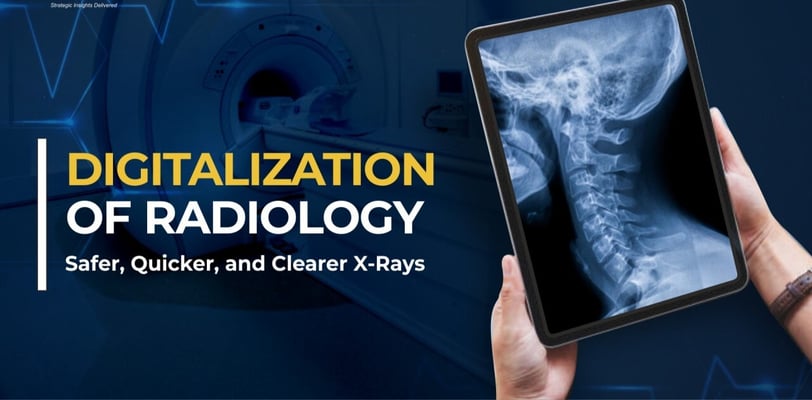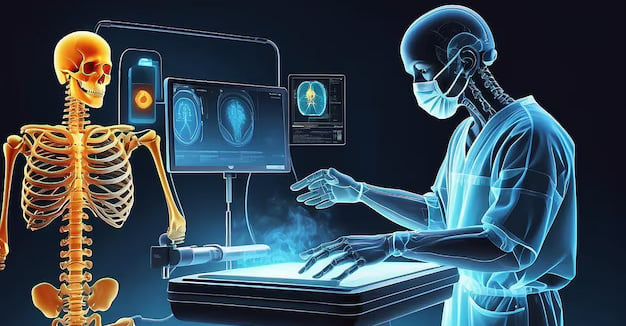Digitalization of Radiology: Transforming Medical Imaging for a Modern World
In today’s rapidly evolving healthcare landscape, technology plays a crucial role in improving patient care and streamlining medical processes. One area that has experienced significant change is radiology. The digitalization of radiology has revolutionized the way healthcare providers capture, store, analyze, and share medical images. But what exactly is the digitalization of radiology, and how is it reshaping the future of healthcare? In this blog, we will explore the transformation from traditional film-based radiology to modern digital imaging systems, the advantages of digitalization, and the future possibilities that lie ahead.
2/17/20254 min read


1. From Film to Digital: A Revolutionary Shift
For decades, radiologists relied on traditional film-based X-rays, which involved capturing images on photographic films that had to be developed manually. The process was time-consuming, and images could degrade over time, making it harder to access or share them when needed.
The introduction of digital radiology marked a breakthrough in medical imaging. With digital systems, X-ray images are converted into electronic data that can be displayed on a computer screen, stored in digital formats, and shared easily across healthcare systems. The most common technologies that enable digital radiology include:
Digital Radiography (DR)
Digital radiography uses digital detectors to capture X-ray images instantly. Unlike traditional films, DR systems allow immediate access to the images and enable better quality control. The images can be enhanced, zoomed in on, and analyzed with precision, improving diagnostic accuracy.Computed Tomography (CT) Scans
CT scans create detailed cross-sectional images of the body by using X-rays and computer processing. Digital CT imaging has enhanced resolution and speed, allowing doctors to diagnose conditions like tumors, infections, or bone fractures with greater accuracy.Magnetic Resonance Imaging (MRI)
While MRI does not use X-rays, the digitalization of MRI systems has brought faster processing, enhanced imaging, and greater patient comfort. Digital MRI images can be shared more easily and analyzed in greater detail, facilitating quicker diagnosis and treatment plans.Picture Archiving and Communication Systems (PACS)
PACS is a medical imaging technology that allows for the digital storage, retrieval, and sharing of radiological images. This system has streamlined image management, making it possible for healthcare professionals to access and collaborate on patient images remotely, at any time.
2. Advantages of Digital Radiology
The digitalization of radiology has brought numerous benefits to healthcare, making it one of the most impactful advancements in modern medicine. Here are some of the key advantages:
Faster and More Efficient Workflow
Digital images are instantly available for viewing on computer screens, eliminating the need for time-consuming film processing and development. This speeds up the diagnostic process, allowing healthcare providers to make faster decisions and provide timely treatment.Improved Image Quality
Digital radiology provides higher-quality images compared to traditional film-based methods. The ability to enhance, zoom, and adjust contrast allows radiologists to detect subtle anomalies that might be missed in film-based images, leading to more accurate diagnoses.Easy Storage and Retrieval
Digital images can be stored electronically in databases, significantly reducing physical storage space and the risk of image degradation over time. These images are easily retrievable for future reference, follow-up treatments, or second opinions. The accessibility of images improves patient care by making historical data readily available.Remote Access and Telemedicine
With digital systems like PACS, radiological images can be accessed remotely, enabling telemedicine and consultations with specialists around the world. This is especially important in rural or underserved areas where access to radiology services might be limited. Remote access allows for quicker consultations, second opinions, and collaborative efforts among specialists.Better Patient Outcomes
Faster and more accurate diagnosis, along with the ability to track changes in a patient's condition over time, directly contributes to better patient outcomes. With digitalization, doctors can detect and treat conditions earlier, improving recovery rates and minimizing the risk of complications.Environmental Benefits
Digital radiology eliminates the need for physical films, chemicals, and paper documentation, making it an eco-friendly alternative. This reduction in the use of film and processing chemicals also leads to a decrease in the environmental impact of medical imaging.
3. Challenges of Digital Radiology
While the benefits of digital radiology are clear, the transition from traditional methods to digital systems is not without its challenges. Some of the key hurdles include:
High Initial Costs
The cost of upgrading to digital imaging systems can be prohibitive, especially for smaller medical practices or hospitals in developing regions. The purchase of digital radiography systems, PACS, and other technologies involves a significant investment in infrastructure, training, and maintenance.Data Security and Privacy Concerns
As digital images are stored electronically and shared over networks, data security becomes a critical issue. Healthcare providers must ensure that patient data is protected from cyber threats and comply with privacy regulations like HIPAA in the U.S. to avoid breaches of confidential medical information.Technology Integration
Integrating digital imaging technologies with existing healthcare systems can be complex. In many cases, hospitals and clinics need to update their software and train staff to use new systems, which can create temporary disruptions in operations.Dependence on Technology
The reliance on digital systems means that any technical glitches or system failures can disrupt the workflow and delay diagnoses. Hospitals must invest in robust IT infrastructure and backup systems to ensure continuous operation.
4. The Future of Digital Radiology
The digitalization of radiology is not stopping at imaging alone. Emerging technologies and innovations are constantly shaping the future of radiology. Some of the most exciting developments include:
Artificial Intelligence (AI) in Radiology
AI has the potential to significantly enhance digital radiology. AI algorithms can help identify patterns in medical images, assist in detecting abnormalities, and even predict disease progression. AI-powered tools are already being used in radiology to assist with tasks like image interpretation, reducing the risk of human error and speeding up diagnoses.3D Imaging and 4D Imaging
Advances in imaging technology are leading to the development of 3D and 4D imaging techniques, which offer a more detailed and dynamic view of the human body. These technologies are particularly useful in the diagnosis and treatment of complex conditions such as cancer, heart disease, and neurological disorders.Integration with Other Healthcare Systems
Digital radiology is increasingly being integrated with electronic health records (EHRs) and other healthcare systems to create a seamless flow of patient data. This integration allows healthcare providers to make better-informed decisions, track patient progress, and collaborate more effectively.Cloud-Based Imaging
Cloud computing is transforming the way medical images are stored and shared. With cloud-based radiology platforms, healthcare providers can access patient images from anywhere, at any time, without the need for local storage infrastructure. This flexibility is particularly beneficial for large networks of hospitals and multi-specialty practices.




Reference Website Link:
RadiologyInfo.org - Digital Radiography
https://www.radiologyinfo.org/en/info/digitalxrayAmerican College of Radiology (ACR) - Digital Radiology
https://www.acr.org/Clinical-Resources/Radiology-Protocols/Digital-RadiographyNational Institute of Biomedical Imaging and Bioengineering (NIBIB)
https://www.nibib.nih.gov/science-education/science-topics/imagingHealthIT.gov - The Role of Health IT in Radiology
https://www.healthit.gov/Mayo Clinic - X-ray Overview
https://www.mayoclinic.org/tests-procedures/x-ray/about/pac-20384918AI in Healthcare - Radiology & Imaging
https://www.healthit.gov/topic/scientific-initiatives/artificial-intelligence/ai-healthcare
Innovative
Contact Us
Service
xraybazar.com
© 2024. All rights reserved.
Address- Rajasthan, India
Gmail Id- xraybazaroffcial.com
Important Links
